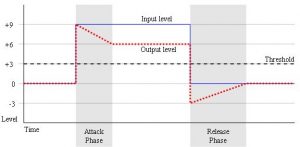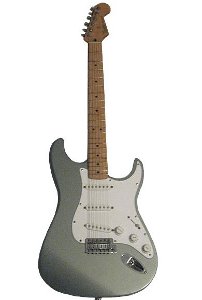Compressing Lead Guitar in the Mix
I received a letter from one of the blog readers asking me for tips on how to compress lead guitar in the mix. I would like to share this to everyone in order for others to know.
————————————————
Hi Tony,
Thanks for contacting me. Compression techniques are actually an art, it depends on creativity and how you are going to set those settings in order to achieve the best sound you want. So that means, my settings in the blog are a little more of guide only.
To answer your question, lead guitar frequencies are often high so compression techniques should be: Lead guitar: Fast attack, Slow release
This is an opposite to bass guitar which is slow attack and fast release. The primary reason is that for bass are low frequencies which means that their period is long (Frequency = 1/Period), the higher the period , the lower will be the frequency, so to have the best compression effect we will wait until it near reaches its maximum amplitude in the wave then there we will start compression (start of attack).
To simplify, picture it as a wave:
Start of wave : amplitude =0
Middle of wave: (max) = 1
End of wave: back to zero since it is a cycle.
Slow attack is applying at the middle or towards the end of the wave, So it means that start of compression(called “attack) is high amplitude then we release it suddenly (release), the resulting sound is BIG.
Here is a very good illustration of how compressor attack and release works.

Lead guitar is fast attack and slow release, so same concept applies but in the opposite. Since they have high frequencies, the period is small (milliseconds). In order to make it stronger, apply compression immediately and release it near the end. The primary reason is that the period is small and to have a stronger sound, longer period in the sound wave are to be applied with compression.
Again settings are for references only; you can start trying at my suggested settings here, General Audio Compression Tips.
Try to experiment….remember that if you set compression ratio at 1:1, it is no compression at all while 2:1 is that the compression factor is twice. The higher the compression ratio it tends to equalize all volumes in the sound wave, “over compression” is bad since you do not have silent areas anymore and all sound waves are now at the same level, resulting in unnatural sound recording.
You can read more about dynamic range compression to understand the science behind audio compression.
Additional Lead Guitar Compression Tips:
1.) When you are compressing, you are reducing the dynamic range of your guitar solo. This can be either be bad or good depending on the music. For example, some guitarist intentionally provide dynamics in their solo to add some realism and feel (e.g. blues guitar solos or in classical guitar music).
However, if you start compressing them you are now taking away some of precious dynamic range of the music. Hence, the guitar solo would now sound bland with reduced dynamics.
2.) Use your ears when compressing the guitar solo. I recommend to start tweaking the threshold first at 30% of the peak guitar solo amplitude then set the compression ratio at 4:1 with attack set at 1ms and release at 50ms.
If you want the dynamics to be reduced, lower down the threshold from 30% of peak amplitude to around 50% until it now sounds even. f there are “pumpy” sections in the guitar solo, you either have to increase the release time or lower the compression ratio until you get the perfect sound.
Thank you so much and Good luck.
Sincerely,
Emerson R. Maningo
From Tony:
———————–
Hi, I was reading your article with interest about compression setting.especially the guitar settings. I’ve bought a Behringer composer pro mdx2200 rack compressor.
I’m recording some lead guitar onto backing tracks. Would i be better treating the lead guitar the same as the vocal settings you have listed, or should i keep the settings you have for guitar?
I know nothing about compression hence the question. I’ve read that some say the ratio should be about 2/1 with a fast attack and slow release to keep the sound on a clean guitar transparent, and not squashed, but i don’t know.
Would appreciate your opinion on this. Also on the attack dial it reads from 1 to 150 ms and the release dial reads from 0.05 to 5 secs.
I know you may think this a silly question but could you tell me how this is read. Im reading it as, the attack 1 is fast and 150 is slow. And on the release 0.05 is fast and the 5 is slow.
It also has an expander gate with the threshold from off to +15 and ratio from 1 to 8 with a fast and slow release button. Could you
give me any advice regarding this. i know I’ve asked a lot of questions but i am a real novice at this. hope you don’t mind me asking. regards tony
Content last updated on August 17, 2012









No responses yet